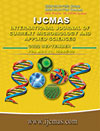


 National Academy of Agricultural Sciences (NAAS)
National Academy of Agricultural Sciences (NAAS)

|
PRINT ISSN : 2319-7692
Online ISSN : 2319-7706 Issues : 12 per year Publisher : Excellent Publishers Email : editorijcmas@gmail.com / submit@ijcmas.com Editor-in-chief: Dr.M.Prakash Index Copernicus ICV 2018: 95.39 NAAS RATING 2020: 5.38 |
The small ruminant husbandry sector in India is not an organized sector like poultry, however, now-a- days many young entrepreneurs are setting up goat units using scientific rearing practices, because small ruminants play an important role in the food and nutritional security of rural people providing meat, milk and skin specially by goat. Due to higher input and output ratio goat is well suited for marginal and landless labor. After extensive comparison with lamb meat difference in flavour, aromas of goat meat have been noted and found huge demand. So, to increase the production potential of goat in term of milk, meat and skin it is necessary to incorporate proper feeding schedule under intensive or semi intensive system of production to achieve optimum animal productivity and economic sustainability. Twenty crossbred (Beetal ï‚´ Assam Local) male goats lambs (6.72 ± 0.24 kg) were randomly distributed into four groups, each with five animals. All groups (T1, T2, T3 & T4) were offered the same concentrate mixture and also offered individual grass and admixture of three fodder as roughage source (50:50) on DM basis. Statistically non significant (p>0.05) difference was observed among the groups in respect of DM intake per 100 kg body weight and per kg W0.75. The digestibility coefficient of DM, OM, CP, EE was significantly higher in group fed Teosinte (T2) and Napier (T3) grass compared to Para (T1) and mix (T4) grass fed groups. However, non significant difference was observed among the groups in respect to digestibility coefficient of NFE, CF, NDF and ADF. Significantly (<0.001) higher final body weight, total gain and average daily gain during entire feeding trial were observed in Teosinte (T2) and Napier (T3) grass fed group. Significantly (< 0.05) lower FCE was observed in both the Teosinte (T2) and Napier (T3) grass fed group.
 |
 |
 |
 |
 |